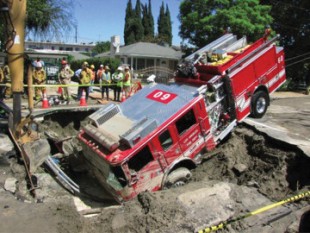Three years after the devastating earthquake, transponders record afterslip deformation on the seabed above the Tohoku-Oki rupture zone.
Hazards & Disasters
High Smog Levels Seen in Mecca During the Annual Pilgrimage
Surveys of air quality show that smog and other pollutants in Islam’s holiest city during the Hajj are among the worst in the world, prompting the Saudi government to look for ways to clear the air.
Group Calls for More Focus on Potentially Hazardous Asteroids
A declaration from astronauts, scientists, and others calls for dramatically increasing the detection and tracking of potentially hazardous near-Earth objects.
Integrated Research Approaches to Coastal Zone Management
India-EU Workshop on Coastal Zone Management and Impact on Society;
Alleppey, India, 6–9 October 2014
Trapping Waves in Earth's Plasmasphere
Satellite observations explain why magnetosonic waves can be found in regions far from where they originate.
Multidisciplinary Monitoring Experiments at Kawah Ijen Volcano
Cities on Volcanoes “Wet Volcanoes” Workshop;
Yogyakarta, Indonesia, 14–21 September 2014
Magnetic Storms and Induction Hazards
Electric fields induced in the Earth's lithosphere during magnetic storms can interfere with the operation of electric power grids. Scientists are working to understand this multifaceted hazard.
Scientists Call for a Renewed Emphasis on Urban Geology
A renewed focus on geological aspects of cities could help mitigate natural hazards and provide a wealth of geological information, scientists say.
Changing Crustal Velocities Preceded 2011 Tohoku-oki Quake
Researchers examined the crustal deformation associated with earthquakes that occurred before the 2011 Tohoku-oki earthquake.
Epidemiology Can Help Predict Urban Water System Failures
How are broken water pipes like fatalities in a heat wave? Researchers look to an epidemiological model to better care for infrastructure.






